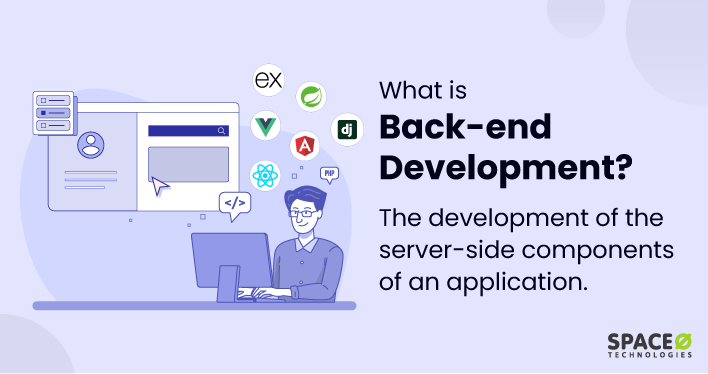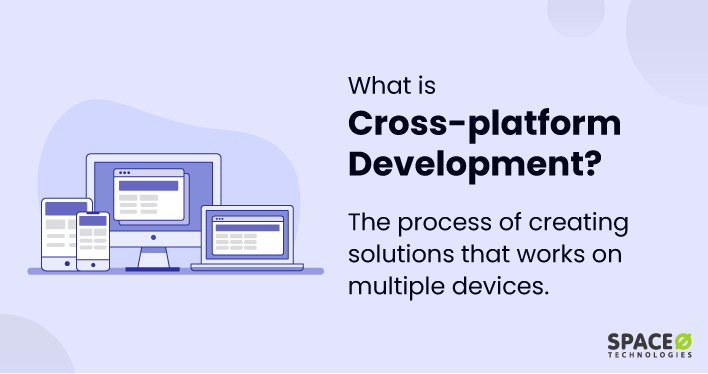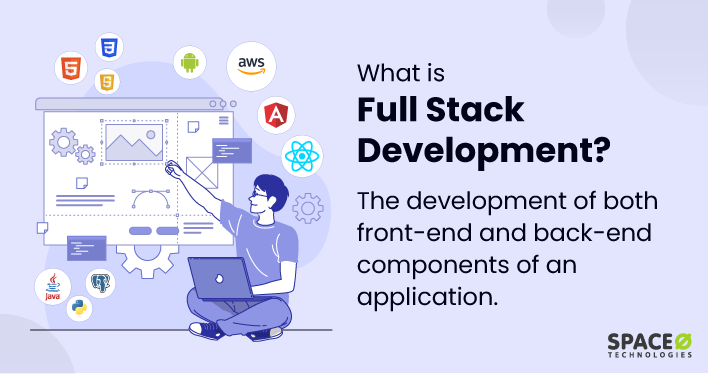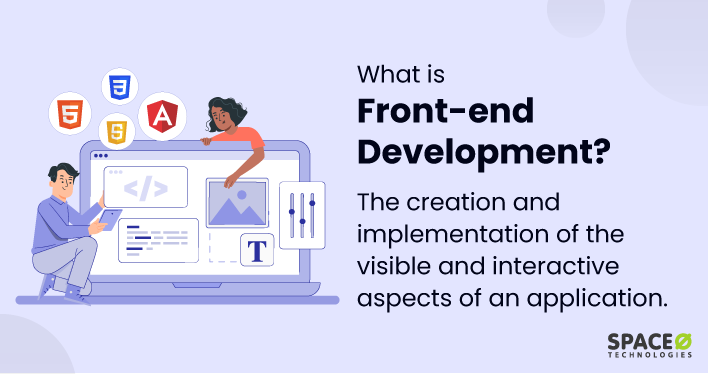Table of Contents
What is Back-end Development?
Back-end development refers to building and managing the server-side elements of web applications and websites. Back-end development focuses on logic, data storage, and integrating services..
In an online store, for instance, the back-end is responsible for essential tasks such as storing product information, processing payments, and managing user accounts. So, when you’re developing the backend of a web app, it’s important to recognize how these tasks interconnect and support the overall functioning of the application. Understanding this process is key to the successful development of any web app. To get an idea of the web app development process, follow this comprehensive guide to creating a web application.
Now, let’s understand the key components of back-end development.
4 Key Components of Back-end Development
Here are the 4 key components that web developers generally use behind the scenes to develop the back-end of a web application.
- Servers: Powerful computers or systems, known as web servers, process requests, host applications, and manage resources. They receive and respond to requests from clients (e.g., web browsers or mobile apps), ensuring the efficient delivery of data and application functionality across the internet.
- Databases: A structured system for storing, managing, and retrieving data, databases are crucial for organizing and maintaining information used by applications. Back-end developers work with various database technologies (e.g., SQL, NoSQL) to design and optimize data storage solutions, such as SQL Server, a popular relational database management system developed by Microsoft.
- Application Programming Interfaces (APIs): A set of rules, protocols, and tools for building software and facilitating communication between different software components, APIs enable the interaction between the front-end and back-end, allowing data exchange and integration with other systems or services, as well as with web servers that host and manage applications.
- Middleware: A layer of software that operates behind the scenes to connect, process, and facilitate communication between various application components, such as relational databases, servers, and APIs. Middleware helps manage and coordinate requests, authentication, and data transformation.
Which Back-end Development Technologies are Used for Developing Web Applications?
For back-end development, programming languages, frameworks, and databases are utilized. Here’s a bifurcated table describing the technology stack of back-end development used by developer for creating web apps.
Let’s first understand programming languages.
| Programming Languages | Description |
|---|---|
| Python | A versatile, high-level programming language known for its readability and ease of use. Widely used in web development, data analysis, and artificial intelligence projects. Supports multiple programming paradigms, including object-oriented, imperative, and functional programming. |
| JavaScript (Node.js) | A server-side runtime environment that enables the use of JavaScript for back-end development, extending its capabilities beyond front end. It is built on Google Chrome’s V8 JavaScript engine and offers an event-driven, non-blocking I/O model, making it efficient for scalable and high-performance applications. |
| PHP | A popular scripting language designed specifically for web development. It can be embedded directly into HTML and supports a wide range of web frameworks. PHP is known for its easy learning curve and is widely used for developing content management systems, blogs, and e-commerce websites. |
| Ruby | A dynamic, object-oriented programming language that emphasizes simplicity, readability, and productivity. It supports multiple programming paradigms, including object-oriented, imperative, and functional programming. Often used with the Ruby on Rails framework for server-side development. |
| Java | A versatile, platform-independent programming language widely used for enterprise applications, web development, and mobile app development. It is object-oriented, class-based, and designed for portability and performance. Java runs on the Java Virtual Machine (JVM), enabling cross-platform compatibility. |
Now, let’s understand the frameworks for back-end development.
| Framework | Programming Languages | Description |
|---|---|---|
| Django | Python | A high-level web framework that promotes rapid development, clean design, and reusability. Django follows the Model-View-Template (MVT) architectural pattern and provides built-in tools for common tasks such as form handling, authentication, and database management. |
| Flask | Python | A lightweight, flexible web framework for building small to medium-sized applications. Flask is easy to set up and allows for more version control over the application’s structure, offering a minimalistic approach compared to Django. It is well-suited for projects that require custom functionality and a lean codebase. |
| Express.js | Node.js | A minimal, unopinionated web framework for building web applications and APIs using Node.js. Express.js simplifies common tasks like routing, middleware integration, and handling HTTP requests. It is highly extensible and allows back-end developers to easily integrate third-party modules or create custom functionality. |
| Ruby on Rails | Ruby | A full-stack web application framework that emphasizes convention over configuration, enabling rapid back-end development. It follows the Model-View-Controller (MVC) architectural pattern and includes built-in tools for database management, form handling, and authentication. Rails supports the DRY (Don’t Repeat Yourself) principle and encourages the use of reusable code. |
| Laravel | PHP | A modern, elegant web application framework for PHP that simplifies common tasks like routing, authentication, caching, and session management. Laravel follows the Model-View-Controller (MVC) architectural pattern and includes an easy-to-use syntax, a powerful ORM (Eloquent), and a robust ecosystem of tools and packages. |
Let’s check the database used for back-end development.
| Database | Type | Description |
|---|---|---|
| MySQL | Relational | A popular open-source relational database management system (RDBMS) that uses SQL for querying and managing data. Known for its speed, reliability, and ease of use, MySQL is widely used in web applications, content management systems, and e-commerce platforms. |
What is the Importance of Back-end Web Development?
Here are the 5 key aspects that highlight the importance of back-end development include
- Manages huge volumes of data: The back-end development enables the efficient handling of data, including storage, retrieval, and manipulation. It ensures that applications can manage vast amounts of data and perform complex operations on it, making it crucial for modern applications that rely on dynamic content.
- Integrates with third-party services: Back-end developers are responsible for integrating various third-party services, such as payment gateways, APIs, and external data sources. These integrations can expand the functionality of a website or application and enhance user experience.
- Streamlines communication: The back-end development facilitates communication between different components of an application, such as the front end, databases, and third-party services. It handles the processing and transmission of data, enabling seamless interactions between various systems and ensuring a smooth user experience.
- Ensures scalability and performance: A well-designed back-end allows an application to scale effectively as user traffic, data volume, or functionality requirements grow. The back-end developers optimize server configurations, database structures, and code to support increased workloads without compromising performance.
- Protects sensitive data: The back-end is responsible for implementing robust authentication and authorization mechanisms, protecting sensitive data, and safeguarding the application against potential threats or vulnerabilities.
Creating a web app requires both front-end and back-end development. Front-end development involves building the user interface that end users see and interact with. This aspect of development is crucial in shaping how users perceive and engage with your web application. If you’re interested in learning more about this, here is an explanation of what is front-end development.
On the other hand, back-end development caters to the server side of the application. To provide a great user experience, both front-end and back-end development must work together in harmony. When a developer combines both front-end and back-end expertise, it is known as full-stack development. For those interested in mastering both sides of web app development, understanding what is full-stack development can provide comprehensive knowledge on web app development.
In conclusion, back-end development is the backbone of web applications, ensuring efficient data management, seamless communication, and robust functionality. A well-designed back-end is essential for providing a secure, scalable, and high-performing user experience.







